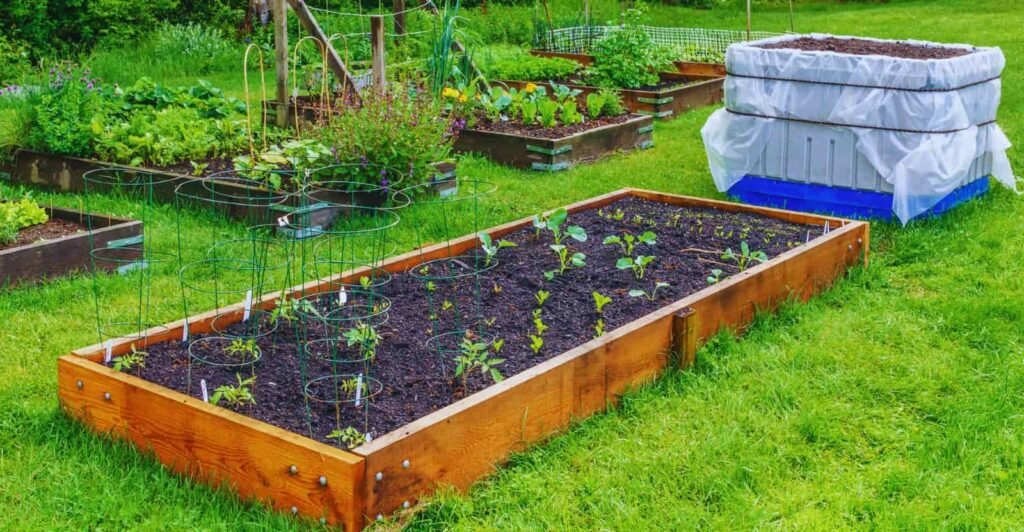
When you’re setting up a new raised garden bed, getting it right from the start is crucial. This is especially true when working with wooden garden beds. The more effectively you use a planter liner, the better the results will be.
A wood-made planter offers a few advantages. It helps keep pests at bay, retains moisture for your plants, and looks great in your garden. Installing and using a liner is simple if you know which materials work best.
If you’re wondering how to make your wooden planter last longer without limiting the types of plants you can grow, we’ve answered the most common questions people have about this topic.
Let’s start with the basics.
Should You Line a Wooden Planter?
Lining a wooden planter has a lot of benefits, though sometimes it might not be necessary. The main reason to use a liner is to extend the lifespan of your planter and prevent any harmful chemicals from treated wood from leaching into the soil of edible plants.
A liner keeps water and fungi from touching the wood, reducing the chances of rot. It also acts as a barrier to stop chemicals from treated wood from seeping into the soil.
Here’s when you might not need to line your wooden planter:
- If you’re using smaller planters that can be easily cleaned after a season (or using plastic planters).
- If you’re not planning to grow edible plants like vegetables or fruit.
- If you’re growing plants that have short growing seasons and you plan to change the potting mix regularly.
- If your planter is made from naturally rot-resistant wood, like redwood or cedar.
On the flip side, you should consider lining your wooden planter in these cases:
- If you have a large commercial-sized planter made of wood and iron nails, which can be more prone to rot and rust.
- If there’s poor air circulation inside the planter, causing soil to become compacted and harder to care for.
- If you want to avoid the hassle of cleaning and drying your planter every season.
- If you’re growing plants that are especially susceptible to fungal infections that could spread to the wood.
- If you’re using a painted planter with lead-based paint, which could leak toxins into your plants, especially edible ones. Lead poisoning can be harmful and affect your nervous system.
How Do You Keep Wooden Planters From Rotting?
The best way to prevent your wooden planters from rotting is by using a high-quality liner. This barrier helps keep moisture and fungi away from the wood, which can extend the life of your planter. Here are some strategies to keep your wooden planter in top shape:
- Line your planter with durable materials. Choose one based on its longevity, ease of installation, and how customizable it is for your needs.
- Ensure your soil is loosely packed to improve airflow around the plants. This will help reduce the chances of rot while encouraging plant growth.
- Don’t overfill your planter with soil. Keep the soil level a couple of inches below the top of the planter.
- Clean your planter every year by removing the soil and wiping the areas around the sealer to prevent moisture from soaking into the wood.
- Remove soil and dead plant material from the sides, and clean with chlorine bleach to kill small pests like termites and fungi.
- Make sure your planter has enough drainage holes to let excess water escape. Too much water can lead to root rot. Drill a few holes if necessary.
- Use commercial potting soil made for pressure-treated lumber planters. These specialized soils include materials like vermiculite, perlite, peat moss, and compost, which are great for reducing the need for frequent watering and helping to prevent wood rot.
What’s the Best Way to Line a Wooden Planter?
There are several ways to line a wooden garden planter, but two methods are more common.
The first option is to use landscape fabric, which you can drape over the sides and tuck into the bottom. The second option is to use a plastic liner (or another material), which you can cut to fit the planter and secure around the inside.
Whatever material you choose, make sure the water can drain from the bottom of the planter. The liner should reach at least one inch up the sides and be two to three inches deep. This helps with proper drainage, prevents root rot, and minimizes fungal issues. You can also apply a waterproofing coat inside the planter for extra protection.
Types of Liner Materials
Here are some common materials used for planter liners:
- Plastic Liner: This is a cheap and easy-to-find option. Thicker plastic sheets (6mm or more) are more durable. You can use things like large black plastic garbage bags or drop cloths to make your own DIY liner. If you want to keep the decorative wood visible, you can choose a transparent plastic liner.
- Flexible Rubber Membrane: Rubber liners are a bit pricier than plastic, but they’re durable and easy to install. Rubber can be cut to fit any shape, and it’s especially easy to work with when it’s warm and sunny. Once in place, you can staple or clip the liner to the wood to keep it secure. You could also use a self-adhesive rubber liner to avoid water leakage.
- Metal Liner: If you have a large planter, a metal liner like copper or galvanized steel might be the best choice. These are strong and durable, and they can support heavy soil without cracking. Copper doesn’t rust, while galvanized liners are also rust-resistant. These liners are trickier to install but are long-lasting.
- Fiberglass Liner: Fiberglass is great for adding color and preventing rot, but it’s a bit brittle and can break easily. It’s best used for custom planters with a pre-installed fiberglass liner, though it can be expensive and harder to install.
Is It Safe to Paint a Wooden Planter with Plants in It?
If you’re thinking of painting a wooden planter that’s already planted, you can definitely do so. Just make sure the paint doesn’t contain harmful chemicals like lead.
Water-based paints are usually safe to use, but they don’t always stick well to wood, meaning you might need to repaint every season.
Conclusion
As you can see, there are plenty of liner options available for wooden planters, each with its pros and cons. To pick the best one, think about the types of plants you’ll be growing and the size of your planter.
If you’re concerned about rot, consider choosing a planter made from naturally rot-resistant woods like cedar and applying a waterproof sealant for extra protection.
